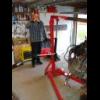All I am saying is that if the maximum load is 3kw that is fixed, the variables are voltage and load (Amps), if the supply voltage drops and the load 3kw stays the same the Amps will increase.
Manufacturers will state the maximum load at a given voltage as below
Technical specificationAir Tank Volume 100 Litres Air Displacement 14.5 cfm Max Working Pressure 116 8 psi/bar Oil/Oil Free Oil Motor (HP) 3.0 HP Input Voltage 230 V Watts 2200 W Wheel Mounted Yes
We may have to agree to disagree on this ?
Hi, thats not correct i'm afraid, as above the only constant is resistance (or as correctly stated above impedance but lets not overcomplicate the problem). The resistance is constant and as the voltage reduces so does the current and also crutially the amount of work done.
As an example we have an experiement at work with two 36kW three phase heaters, I had the supplies installed but it wouldn't reach the correct temperature. When I went over and looked at the heaters that had been purchased by the faculty they were 480v not 400v and this small diference in voltage reduced their output to around 25kW each.
As these were the only suitable heaters available (and we already had them) I put a 400 -480V step up transformer on them and it fixed the problem.
If you want to understand more about this look up voltage otimising transformers like the PowerPerfector, basically these save energy by reducing the voltage and hence the amount of work done by all electrical equipment connected with a fixed output (i.e. a light), anything with a variable output (like a kettle, oven etc.) where the work done is regulated by a control will save nothing. These only work on older buildings/equipment as more and more modern systems have a variable/regulated output.















